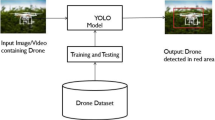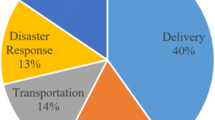Abstract
Surveillance drones are remarkable devices for monitoring, as they have strong spatial and remote sensing capabilities. The prompt detection of peripheral damage to the blades of wind turbines is necessary to reduce downtime and prevent the potential failure of wind farms. Computer vision breakthroughs with deep learning have developed and been refined over time, mainly using convolution neural networks. From this perspective, we suggest a deep learning model for monitoring and diagnosing the blade health of wind turbines based on images captured by surveillance drones. The main limitations of standard monitoring devices are their poor detection accuracy and lack of real-time performance, making it complex to obtain the attributes of blades from aerial images. Based on the foregoing, this study introduces a method for increasing detection accuracy when carrying out operations in real time using You Only Look at Once version 3 (YOLOv3). We train and evaluate three deep learning models on the wind turbine image dataset. We find that many aerial images are unclear because of blurred motion. As avoiding such low-resolution images for training can affect accuracy, we use a super-resolution convolution neural network to reconstruct a blurred picture as a high-resolution one. The computational results demonstrate that YOLOv3 outperforms traditional models in terms of both accuracy and handling time.











Similar content being viewed by others
Availability of data and material
The full data of the current study are available from the corresponding author on reasonable request.
References
Abualigah LM, Khader AT, Hanandeh ES (2018) A hybrid strategy for krill herd algorithm with harmony search algorithm to improve the data clustering. Intell Dec Technol 12(1):3–14
Abualigah L, Shehab M, Alshinwan M, Alabool H (2019) Salp swarm algorithm: a comprehensive survey. Neural Comput Appl 2019:1–21
Al-Khudairi O, Ghasemnejad H (2015) To improve failure resistance in joint design of composite wind turbine blade materials. Renew Energy 81:936–951
Chen H, He Z, Shi B, Zhong T (2019) Research on recognition method of electrical components based on yolo v3. IEEE Access 7:157818–157829
Dong C, Loy CC, He K, Tang X (2014) Learning a deep convolutional network for image super-resolution. Eur Conf Comput Vis 2014:184–199
Dong C, Loy CC, Tang X (2016) Accelerating the super-resolution convolutional neural network. Eur Conf Comput Vis 2016:391–407
Druzhkov P, Kustikova V (2016) A survey of deep learning methods and software tools for image classification and object detection. Pattern Recogn Image Anal 26(1):9–15
Dutton AG (2004) Thermoelastic stress measurement and acoustic emission monitoring in wind turbine blade testing. Eur Wind Energy Conf Lond 2004:22–25
Elsaid NM, Wu Y-C (2019) Super-resolution diffusion tensor imaging using srcnn: a feasibility study. In: 2019 41st annual international conference of the IEEE engineering in medicine and biology society (EMBC), IEEE, pp 2830–2834
Ghenescu V, Mihaescu RE, Carata S-V, Ghenescu MT, Barnoviciu E, Chindea M (2018) Face detection and recognition based on general purpose dnn object detector. In: 2018 international symposium on electronics and telecommunications (ISETC), IEEE, pp 1–4
Häckell MW, Rolfes R (2013) Monitoring a 5 mw offshore wind energy converter—condition parameters and triangulation based extraction of modal parameters. Mech Syst Signal Process 40(1):322–343
Hosoi A, Yamaguchi Y, Ju Y, Sato Y, Kitayama T (2015) Detection and quantitative evaluation of defects in glass fiber reinforced plastic laminates by microwaves. Compos Struct 128:134–144
Jasinien E, Raiutis R, Voleiis A, Vladiauskas A, Mitchard D, Amos M et al (2009) Ndt of wind turbine blades using adapted ultrasonic and radiographic techniques. Insight-Non-Destruct Test Condition Monitor 51(9):477–483
Khalilpourazari S, Khalilpourazary S (2018) Optimization of time, cost and surface roughness in grinding process using a robust multi-objective dragonfly algorithm. Neural Comput Appl 2018:1–12
Khalilpourazari S, Pasandideh SHR (2019) Sine-cosine crow search algorithm: theory and applications. Neural Comput Appl 2019:1–18
Khalilpourazari S, Soltanzadeh S, Weber G-W, Roy SK (2019) Designing an efficient blood supply chain network in crisis: neural learning, optimization and case study. Ann Oper Res 2019:1–30
Khalilpourazari S, Mohammadi M (2018) A new exact algorithm for solving single machine scheduling problems with learning effects and deteriorating jobs. arXiv:1809.03795
Kingma DP, Ba JA (2019) A method for stochastic optimization. arXiv:1412.6980
Krause T, Ostermann J (2020) Damage detection for wind turbine rotor blades using airborne sound. Struct Control Health Monitor 27(5):e2520
Lee J-K, Park J-Y, Oh K-Y, Ju S-H, Lee J-S (2015) Transformation algorithm of wind turbine blade moment signals for blade condition monitoring. Renew Energy 79:209–218
Li Z, Haigh A, Soutis C, Gibson A, Sloan R, Karimian N (2016a) Delamination detection in composite t-joints of wind turbine blades using microwaves. Adv Compos Lett 25(4):096369351602500401
Light-Marquez A, Sobin A, Park G, Farinholt K (2011) Structural damage identification in wind turbine blades using piezoelectric active sensing. Struct Dyn Renew Energy 1:55–65
Lin T-Y, Dollár P, Girshick R, He K, Hariharan B, Belongie S (2017) Feature pyramid networks for object detection. In: Proceedings of the IEEE conference on computer vision and pattern recognition, pp 2117–2125
Li Z, Soutis C, Haigh A, Sloan R, Gibson A, Karimian N (2016b) Microwave imaging for delamination detection in t-joints of wind turbine composite blades. In: 2016 46th European Microwave Conference (EuMC), IEEE, pp 1235–1238
Liu W, Anguelov D, Erhan D, Szegedy C, Reed S, Fu C-Y, Berg AC (2016) SSD: Single shot multibox detector. Eur Conf Comput Vis 2016:21–37
Mandell JF, Samborsky DD, Agastra P (2008) Composite materials fatigue issues in wind turbine blade construction. In: SAMPE 2008
Nair V, Hinton GE (2010) Rectified linear units improve restricted boltzmann machines. In: Proceedings of the 27th international conference on machine learning (ICML-10), pp 807–814
Ozbek M, Meng F, Rixen DJ (2013) Challenges in testing and monitoring the in-operation vibration characteristics of wind turbines. Mech Syst Signal Process 41(1–2):649–666
Pandit RK, Infield D (2019) Comparative assessments of binned and support vector regression-based blade pitch curve of a wind turbine for the purpose of condition monitoring. Int J Energy Environ Eng 10(2):181–188
Pitchford C, Grisso BL, Inman DJ (2007) Impedance-based structural health monitoring of wind turbine blades. In: Health monitoring of structural and biological systems 2007, vol 6532, pp 65321I. International Society for Optics and Photonics
Prowell I, Veletzos M, Elgamal A, Restrepo J (2009) Experimental and numerical seismic response of a 65 kw wind turbine. J Earthq Eng 13(8):1172–1190
Raišutis R, Jasiūnienė E, Žukauskas E (2008) Ultrasonic ndt of wind turbine blades using guided waves. Ultrasound 63(1):7–11
Rao C, Fan Y, Su K, Latecki LJ (2019) Common object discovery as local search for maximum weight cliques in a global object similarity graph. In: International conference on discrete geometry for computer imagery, Springer, pp 219–233
Reddy A, Indragandhi V, Ravi L, Subramaniyaswamy V (2019) Detection of cracks and damage in wind turbine blades using artificial intelligence-based image analytics. Measurement 147:106823
Redmon J, Divvala S, Girshick R, Farhadi A (2016) You only look once: Unified, real-time object detection. In: Proceedings of the IEEE conference on computer vision and pattern recognition, pp 779–788
Redmon J, Farhadi A (2017) Yolo9000: better, faster, stronger. In: Proceedings of the IEEE conference on computer vision and pattern recognition, pp 7263–7271
Redmon J, Farhadi A (2018) Yolov3: an incremental improvement. arXiv:1804.02767
Ren S, He K, Girshick R, Sun J (2015) Faster r-cnn: Towards real-time object detection with region proposal networks. Adv Neural Inf Process Syst 2015:91–99
Ruder S (2016) An overview of gradient descent optimization algorithms. arXiv:1609.04747
Shehab M, Abualigah L, Al Hamad H, Alabool H, Alshinwan M, Khasawneh AM (2019) Moth-flame optimization algorithm: variants and applications. Neural Comput Appl 2019:1–26
Shehab M, Alshawabkah H, Abualigah L, Nagham A-M (2020) Enhanced a hybrid moth-flame optimization algorithm using new selection schemes. Eng Comput 2020:1–26
Shihavuddin ASM, Chen X (2018) DTU - Drone inspection images of wind turbine. Mendeley Data, V2. https://doi.org/10.17632/hd96prn3nc.2
Shihavuddin A, Chen X, Fedorov V, Christensen AN, Riis NAB, Branner K, Dahl AB, Paulsen RR (2019) Wind turbine surface damage detection by deep learning aided drone inspection analysis. Energies 12(4):676
Sørensen BF, Lading L, Sendrup P, McGugan M, Debel CP, Kristensen OJD, Larsen GC, Hansen AM, Rheinländer J, Rusborg J, Vestergaard JD (2002) Fundamentals for remote structural health monitoring of wind turbine blades-a preproject. Risø National Laboratory, Denmark. Forskningscenter Risoe. Risoe-R, 1336 p
Sutherland H, Beattie A, Hansche B, Musial W, Allread J, Johnson J, Summers M (1994) The application of non-destructive techniques to the testing of a wind turbine blade. In: Technical report, Sandia National Labs., Albuquerque, NM (United States)
Szegedy C, Ioffe S, Vanhoucke V, Alemi AA (2017) Inception-v4, Inception-ResNet and the Impact of Residual Connections on Learning. AAAI
Tian Y, Yap K-H, He Y (2012) Vehicle license plate super-resolution using soft learning prior. Multimedia Tools Appl 60(3):519–535
Tu T-H, Lo F-C, Liao C-C, Chung C-F, Chen R-C (2019) Using wind turbine noise to inspect blade damage through portable device. Inst Noise Control Eng 259–8:1787–1791
Wang L, Zhang Z (2017) Automatic detection of wind turbine blade surface cracks based on UAV-taken images. IEEE Trans Industr Electron 64(9):7293–7303
Wang L, Zhang Z, Xu J, Liu R (2016) Wind turbine blade breakage monitoring with deep autoencoders. IEEE Trans Smart Grid 9(4):2824–2833
Yu Y, Cao H, Yan X, Wang T, Ge SS (2020) Defect identification of wind turbine blades based on defect semantic features with transfer feature extractor. Neurocomputing 376:1–9
Zhao J, Qu J (2018) Healthy and diseased tomatoes detection based on yolov2. Int Conf Hum Center Comput 2018:347–353
Zhou R, Achanta R, Süsstrunk S (2018) Deep residual network for joint demosaicing and super-resolution. In: Color and imaging conference, vol 2018, pp 75–80. Society for imaging science and technology
Acknowledgements
We would like to thank the TEQIP-III for sponsoring the seed project fund.
Author information
Authors and Affiliations
Corresponding author
Ethics declarations
Conflict of interest
The authors declare that they have no known competing financial interests or personal relationships that could have appeared to influence the work reported in this paper.
Additional information
Publisher's Note
Springer Nature remains neutral with regard to jurisdictional claims in published maps and institutional affiliations.
Rights and permissions
About this article
Cite this article
Sarkar, D., Gunturi, S.K. Wind turbine blade structural state evaluation by hybrid object detector relying on deep learning models. J Ambient Intell Human Comput 12, 8535–8548 (2021). https://doi.org/10.1007/s12652-020-02587-7
Received:
Accepted:
Published:
Issue Date:
DOI: https://doi.org/10.1007/s12652-020-02587-7




